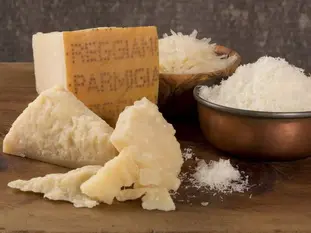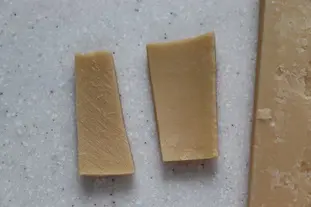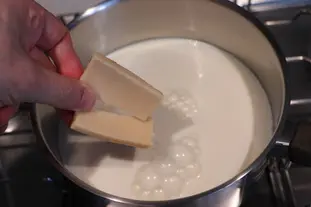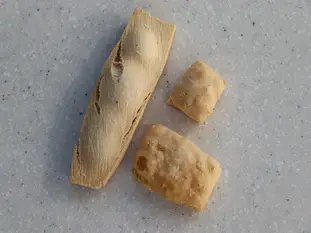This site uses only a few technical cookies necessary for its operation. By continuing to browse, you accept their use.
To find out more...
To find out more...
Parmesan cheese crusts

If you use Parmesan cheese (Parmigiano Reggiano) in your recipes, you may have already noticed: when you grate it, it becomes (very) difficult near the crust, especially if it is a slightly aged parmesan, as the cheese gets harder and harder.
So we stop grating, leaving some crust on top, and a certain thickness of cheese. What will happen to these crusts?
So we stop grating, leaving some crust on top, and a certain thickness of cheese. What will happen to these crusts?
17 K 4.9/5 (20 reviews)
Keywords for this post:RecoveryLeftoversCheeseSavingsLast modified on: September 14th 2022
Parmesan cheese crusts
Let's start with an observation: these crusts are generally as hard as wood!
You've done all you can, but it's impossible to grate more, especially by hand - too hard, and you risk injuring your fingertips with the grater if you press too hard.
You can also prepare a parmesan milk that you can use later in a recipe.
The resulting Parmesan oil will add a pleasant aroma to your sauces or pasta dishes.
To sum up: Parmesan crumbles should not be thrown away - it would be a pity. It's better to use them in cooking, either hot (soups, sauces, in the oven, etc.), or cold (macerated in olive oil).
You've done all you can, but it's impossible to grate more, especially by hand - too hard, and you risk injuring your fingertips with the grater if you press too hard.

In a hot, liquid preparation
It's very simple: as soon as you prepare something hot and liquid - a soup, gratin or sauce, for example - add your croutons as soon as you start cooking, and let them flavour your preparation deliciously throughout. Remove them before blending (soups) or using, noting that they have become soft and can be eaten.
You can also prepare a parmesan milk that you can use later in a recipe.
In the oven
You can place your croutes in the oven for a few minutes at 180°C (360°F), where they will puff up and become crispy, ideal for serving as an aperitif, for example.
Parmesan olive oil
Cut your croutes into small pieces, place in a jar with a lid, cover with olive oil and leave to macerate for at least 15 days.The resulting Parmesan oil will add a pleasant aroma to your sauces or pasta dishes.
To sum up: Parmesan crumbles should not be thrown away - it would be a pity. It's better to use them in cooking, either hot (soups, sauces, in the oven, etc.), or cold (macerated in olive oil).
Lasts posts
Butter vs. grease
We often read in a recipe where a pastry is put into a mould that, just before pouring, the mould should be buttered or greased. But what's the difference between these 2 terms?December 1st 20259715
Getting out of the fridge early
Very often when you're cooking, you need to take food or preparations out of the fridge, to use them in the recipe in progress. There's nothing tricky about this: you just take them out of the fridge and use them, usually immediately, in the recipe. But is this really a good method?November 24th 20251,1085
Who's making the croissants?
When you look at a bakery from the outside, you naturally think that in the bakery, the bakers make the bread, and in the laboratory, the pastry chefs make the cakes. It's very often like that, with each of these professions having quite different ways of working, but sometimes there's also one...November 23th 2025999
Oven height
When we put a dish or cake in the oven, we naturally tend to put it on the middle shelf, and that's what we usually do. But in some cases, this position and height can be a little tricky, so let's find out why.October 8th 20252,7315
The importance of sieving
In recipes that use a fine powder (flour, powdered sugar, etc.), you'll often see the advice to sift before using it. To sift is to pass the powder in question through a sieve (a very fine strainer) before incorporating it into your recipe. It's often advice, but is it really useful?September 3rd 20257,5273
Other pages you may also like
How to sprinkle well?
When in a recipe you need to sprinkle something, that is to say to spread a fine layer of powder (flour, sugar, etc.) on something, powdered sugar on a pie for example, you will probably use a fine strainer or a sieve, this is the best way to proceed. But is that all?May 23th 202310 K4.7
Tranché, dissociated, failed, in short... missed!
When preparing a sauce or a cream, there's always a (small) risk that the creamy preparation you're working on will suddenly separate into two parts of different textures: a liquid part, for example, and a more or less solid part, or even become lumpy. It's terribly frustrating, but we'll see...June 19th 202313 K5
The return of the "Norman hole"
You maybe know the "trou normand", this old gastronomic custom typically French which consists in taking a (small) glass of calvados, generally between the last course and the dessert? It's something that seems a bit anachronistic nowadays, having a glass of an alcohol of more than 60° in the...December 18th 202115 K4.8
The window-pane test in bread-making
The home bread-makers often ask themselves “Have I kneaded my dough long enough?” . A good question, as dough that is insufficiently kneaded will not rise properly or will fall flat when the top is slashed, which is very frustrating. To know when the dough is ready, one can rely on the length...June 16th 202196 K 23.9
Perpetual stock
It's something you have probably have done yourself: cooked or pre-cooked vegetables before adding them to a recipe. This is almost always done the same way: peel the chosen vegetables (carrots, for example), cut them up, boil them in salted water (using a tablespoon or so of coarse salt per litre),...November 22th 201631 K5
Post a comment or question
Follow this page
If you are interested in this page, you can "follow" it, by entering your email address here. You will then receive a notification immediately each time the page is modified or a new comment is added. Please note that you will need to confirm this following.
Note: We'll never share your e-mail address with anyone else.
Alternatively: you can subscribe to the mailing list of cooling-ez.com , you will receive a e-mail for each new recipe published on the site.









